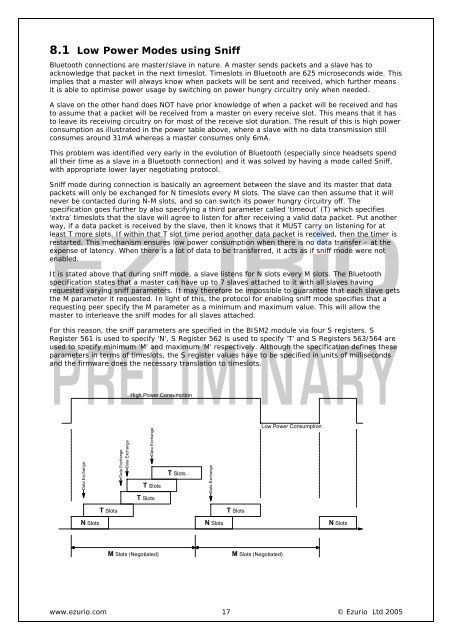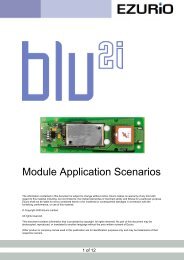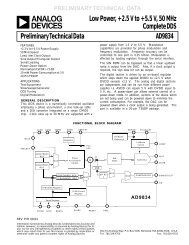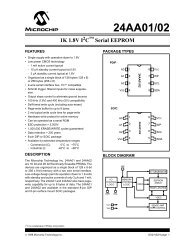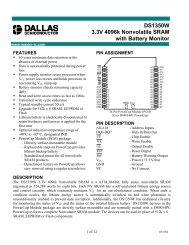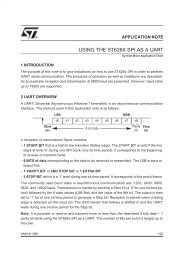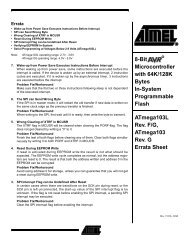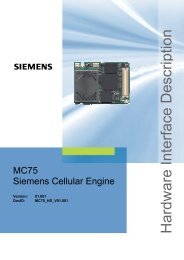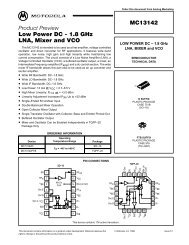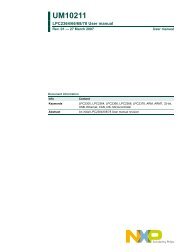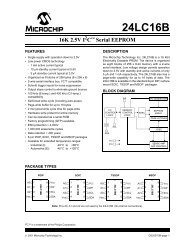Hardware Interface Description - Standard ICs
Hardware Interface Description - Standard ICs
Hardware Interface Description - Standard ICs
Create successful ePaper yourself
Turn your PDF publications into a flip-book with our unique Google optimized e-Paper software.
8.1 Low Power Modes using SniffBluetooth connections are master/slave in nature. A master sends packets and a slave has toacknowledge that packet in the next timeslot. Timeslots in Bluetooth are 625 microseconds wide. Thisimplies that a master will always know when packets will be sent and received, which further meansit is able to optimise power usage by switching on power hungry circuitry only when needed.A slave on the other hand does NOT have prior knowledge of when a packet will be received and hasto assume that a packet will be received from a master on every receive slot. This means that it hasto leave its receiving circuitry on for most of the receive slot duration. The result of this is high powerconsumption as illustrated in the power table above, where a slave with no data transmission stillconsumes around 31mA whereas a master consumes only 6mA.This problem was identified very early in the evolution of Bluetooth (especially since headsets spendall their time as a slave in a Bluetooth connection) and it was solved by having a mode called Sniff,with appropriate lower layer negotiating protocol.Sniff mode during connection is basically an agreement between the slave and its master that datapackets will only be exchanged for N timeslots every M slots. The slave can then assume that it willnever be contacted during N-M slots, and so can switch its power hungry circuitry off. Thespecification goes further by also specifying a third parameter called ‘timeout’ (T) which specifies‘extra’ timeslots that the slave will agree to listen for after receiving a valid data packet. Put anotherway, if a data packet is received by the slave, then it knows that it MUST carry on listening for atleast T more slots. If within that T slot time period another data packet is received, then the timer isrestarted. This mechanism ensures low power consumption when there is no data transfer – at theexpense of latency. When there is a lot of data to be transferred, it acts as if sniff mode were notenabled.It is stated above that during sniff mode, a slave listens for N slots every M slots. The Bluetoothspecification states that a master can have up to 7 slaves attached to it with all slaves havingrequested varying sniff parameters. It may therefore be impossible to guarantee that each slave getsthe M parameter it requested. In light of this, the protocol for enabling sniff mode specifies that arequesting peer specify the M parameter as a minimum and maximum value. This will allow themaster to interleave the sniff modes for all slaves attached.For this reason, the sniff parameters are specified in the BISM2 module via four S registers. SRegister 561 is used to specify ‘N’, S Register 562 is used to specify ‘T’ and S Registers 563/564 areused to specify minimum ‘M’ and maximum ‘M’ respectively. Although the specification defines theseparameters in terms of timeslots, the S register values have to be specified in units of millisecondsand the firmware does the necessary translation to timeslots.High Power ConsumptionData ExchangeData ExchangeData Exchange ExhangeData ExchangeT SlotsT SlotsData ExchangeLow Power ConsumptionT SlotsT SlotsT SlotsN Slots N Slots N SlotsM Slots (Negotiated)M Slots (Negotiated)www.ezurio.com 17© Ezurio Ltd 2005


